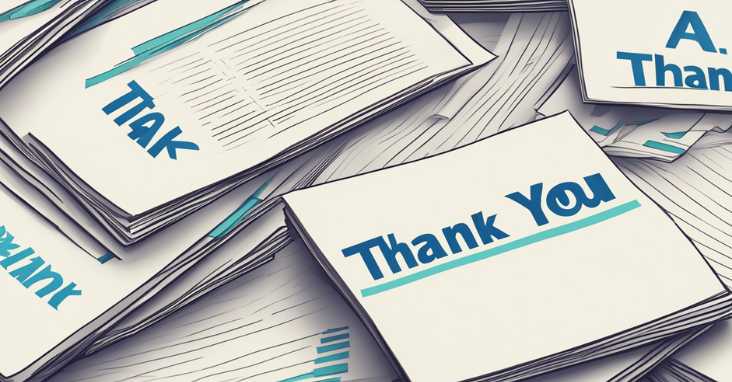How to communicate effectively in challenging situations with thank you for your understanding ? Stay calm, listen actively, empathize, and articulate gratitude with ‘Thank you for your understanding’ to navigate challenging talks effectively.
Thank you for your understanding is a phrase commonly used in communication to express gratitude towards someone who has shown patience or empathy in a given situation. It is a polite way of acknowledging the other person’s efforts to cooperate or accommodate a request, even if it may have caused inconvenience or difficulty. This phrase is often used in professional settings, such as in customer service, business negotiations, or workplace interactions, but it can also be used in personal relationships to show appreciation and respect.

The Importance of Gratitude in Communication
Expressing appreciation and gratitude is an essential aspect of effective communication, as it helps to build trust, rapport, and positive relationships. When people feel appreciated and valued, they are more likely to be motivated, engaged, and loyal. On the other hand, when people feel ignored, dismissed, or taken for granted, they may become resentful, disengaged, or hostile. Therefore, expressing gratitude and appreciation can have a significant impact on the quality of communication and the outcomes of interactions.
Key Takeaways
- Thank you for your understanding is a polite way of expressing gratitude towards someone who has shown patience or empathy in a given situation.
- Gratitude and appreciation are essential aspects of effective communication, as they help to build trust, rapport, and positive relationships.
- Expressing appreciation can have a significant impact on the quality of communication and the outcomes of interactions.
The Importance of Gratitude in Communication

In any form of communication, expressing gratitude is a crucial element that can help build positive relationships and enhance professionalism. When people feel appreciated and valued, they are more likely to trust and respect the person they are communicating with. In this section, we will discuss the importance of gratitude in communication and how it can benefit both personal and professional relationships.
Building Positive Relationships
Expressing gratitude is an effective way to build positive relationships. When people feel appreciated and valued, they are more likely to feel connected to the person they are communicating with. This can lead to a stronger bond and a more positive interaction. Additionally, expressing gratitude can help establish trust between individuals. When people feel that their efforts are recognized and appreciated, they are more likely to feel comfortable sharing their thoughts and ideas.
One way to express gratitude is to say “thank you.” Saying thank you is a simple yet powerful way to show appreciation. It can be used in a variety of situations, from receiving a gift to completing a task. Additionally, expressing gratitude can be done through nonverbal communication, such as a smile or a nod of the head.
Enhancing Professionalism
Gratitude can also enhance professionalism. In a professional setting, expressing gratitude can show that an individual is respectful and appreciative of their colleagues. This can lead to a more positive work environment and can help foster a sense of teamwork and collaboration.
One way to express gratitude in a professional setting is to send a thank-you note or email. This can be done after a meeting, presentation, or project. Additionally, expressing gratitude can be done through small gestures, such as bringing in treats or offering to help a colleague with a task.
Overall, expressing gratitude is an important element in communication. It can help build positive relationships, enhance professionalism, and establish trust between individuals. By incorporating gratitude into their communication style, individuals can create a more positive and respectful environment. For more information on the importance of gratitude in communication, visit Psychology Today.
Expressing Understanding and Patience
When things go wrong, it is important to express understanding and patience towards those affected. This can go a long way in maintaining positive relationships and avoiding further frustrations. In this section, we will explore two key ways to express understanding and patience: acknowledging inconveniences and conveying sincere apologies.
Acknowledging Inconveniences
Acknowledging the inconvenience caused is an important step in expressing understanding. By doing so, one shows empathy towards those affected and recognizes the impact of the situation. This can be done through various means such as a verbal apology or a written message.
For instance, a company experiencing a delay in product delivery can acknowledge the inconvenience caused to its customers by sending an email or message that reads, “We understand that the delay in product delivery has caused inconvenience to our customers. We appreciate your patience and understanding as we work to resolve the issue.”
Conveying Sincere Apologies
Conveying sincere apologies is another important way to express understanding and patience. A sincere apology shows that the person or organization responsible takes responsibility for the situation and is committed to making things right.
When conveying a sincere apology, it is important to use language that conveys genuine remorse and a commitment to making amends. For example, a message that reads, “We sincerely apologize for the inconvenience caused and are working hard to resolve the issue. Thank you for your understanding and patience” can go a long way in maintaining positive relationships.
In conclusion, expressing understanding and patience through acknowledging inconveniences and conveying sincere apologies is crucial in maintaining positive relationships and avoiding further frustrations. By doing so, one shows empathy towards those affected and takes responsibility for the situation. For more information on how to express understanding and patience, please refer to this article by Forbes.
The Role of Empathy in the Workplace
Empathy is an essential quality that can help foster teamwork, cooperation, and a positive work environment. It is the ability to understand and share the feelings of others, which is crucial in any workplace setting. In this section, we will explore how empathy can play a significant role in the workplace, specifically in handling complaints and dissatisfaction.
Fostering Teamwork and Cooperation
Empathy can help create a culture of teamwork and cooperation. When employees feel that their colleagues and bosses understand and care about their concerns, they are more likely to work together effectively. By showing empathy, employees can build trust and respect, which can lead to better communication and collaboration.
One way to foster empathy in the workplace is by encouraging employees to share their experiences and perspectives. This can be done through team-building exercises or group discussions. By listening to each other, employees can gain a better understanding of their colleagues’ needs and challenges, which can help them work together more effectively.
Handling Complaints and Dissatisfaction
Empathy is also crucial in handling complaints and dissatisfaction in the workplace. When employees feel that their concerns are being heard and addressed, they are more likely to be satisfied with their jobs and work harder. On the other hand, if complaints are ignored or dismissed, it can lead to frustration and resentment.
One way to show empathy when handling complaints is by actively listening to the employee’s concerns. This means giving them your full attention and trying to understand their perspective. It is also essential to acknowledge their feelings and validate their experiences, even if you don’t agree with them.
Another way to show empathy is by offering solutions or alternatives. This can help employees feel that their concerns are being taken seriously and that their input is valued. By working together to find a solution, employees can feel empowered and invested in the outcome.
In conclusion, empathy is an essential quality in any workplace setting. By fostering teamwork and cooperation and handling complaints and dissatisfaction, empathy can help create a positive work environment and improve employee satisfaction. For more information on the role of empathy in the workplace, check out this article from Forbes.
Effective Use of Appreciative Language

Appreciative language is an essential tool for conveying gratitude and respect in professional communication. When used effectively, it can strengthen relationships, build trust, and increase the likelihood of achieving a positive outcome. In this section, we will explore some best practices for using appreciative language in your communication.
Choosing the Right Words and Phrases
One of the keys to using appreciative language effectively is to choose the right words and phrases. Using polite and formal language is essential in professional communication. When expressing gratitude, it is important to use words that convey sincerity and appreciation. Some examples of effective appreciative language include:
- Thank you for your understanding.
- We appreciate your flexibility.
- Your support is greatly appreciated.
- Thank you for considering alternatives.
- We appreciate your professionalism.
Using synonyms and different turns of phrase can also help to avoid repetition and keep the language fresh. However, it is important to avoid vague or overly formal language that can make the communication sound insincere or robotic.
Avoiding Repetition and Vagueness
Repetition and vagueness can detract from the effectiveness of appreciative language. Using the same phrase repeatedly can make it sound insincere or robotic. On the other hand, using vague language can make the communication sound unclear or confusing.
To avoid repetition, try using synonyms or different turns of phrase. For example, instead of saying “thank you for your understanding” repeatedly, try saying “we appreciate your patience” or “thank you for your cooperation.”
To avoid vagueness, be specific about what you are appreciating. For example, instead of saying “thank you for your help,” try saying “thank you for your assistance with the project.”
By following these best practices, you can use appreciative language effectively to strengthen relationships and achieve positive outcomes in your professional communication.
For more tips on effective communication in the workplace, check out this resource from MindTools.
Scenarios Requiring Appreciation

In any project, there are times when unforeseen circumstances arise, and schedules need to be adjusted. During these times, it’s essential to show appreciation to those who have been affected by the changes. Here are two common scenarios that require gratitude:
Project Delays and Rescheduling
Project delays and rescheduling can be frustrating for everyone involved. However, it’s essential to show appreciation to those who have been affected by the changes. This includes the project team, stakeholders, and customers.
One way to show appreciation is by keeping everyone informed of the changes. This includes providing regular updates on the progress of the project and any changes to the timeline. It’s also important to acknowledge the inconvenience caused by the delay and express gratitude for their patience and saying thank you for your understanding.
Extra Effort and Dedication
Sometimes, a project requires extra effort and dedication from team members. This may be due to unforeseen circumstances, tight deadlines, or unexpected changes to the project scope.
In these situations, it’s important to recognize and appreciate the extra effort and dedication put in by team members. This can be done by acknowledging their hard work and expressing gratitude for their commitment to the project’s success.
Overall, showing appreciation and consideration in these scenarios can help build stronger relationships and foster a positive work environment. Thanking those involved for their help and understanding can go a long way in maintaining a productive and collaborative team.
Here is an external resource with tips on how to show appreciation to employees.
Crafting Thank You Messages

Expressing gratitude is a powerful way to create a lasting impression on someone. Whether it is through emails, letters, or in-person conversations, saying thank you for your understanding, patience, and compassion can have an impactful effect on the recipient. Here are some tips for crafting thank you messages that convey gratitude and appreciation.
Structuring Emails and Letters
When writing a thank you email or letter, it is important to structure the message in a clear and concise manner. Start by expressing gratitude and acknowledging the recipient’s understanding or patience. Be specific about what you are thankful for and how it has impacted you. For example:
“Thank you for your understanding during this difficult time. Your compassion and encouragement have helped me stay positive and focused on the future.”
Next, highlight the impact that the recipient’s actions have had on you. This will help them understand the significance of their support and encourage them to continue providing it in the future. Finally, close the message with a sincere expression of gratitude and a positive note. Here is an example:
“I am grateful for your patience and understanding, and I appreciate all that you have done for me.”, “Thank you for being such an important part of my life.”, “Thank you for your understanding of this situation”
Expressing Gratitude in Person
When expressing gratitude in person, it is important to be sincere and authentic. Start by listening actively to the recipient and acknowledging their understanding or patience. Be specific about what you are thankful for and how it has impacted you. For example:
“I want to thank you for your understanding during this difficult time. Your compassion and encouragement have helped me stay positive and focused on the future.”
Next, highlight the impact that the recipient’s actions have had on you. This will help them understand the significance of their support and encourage them to continue providing it in the future. Finally, close the conversation with a sincere expression of gratitude and a positive note. Here is an example:
“Thank you for your understanding and patience, and I appreciate all that you have done for me. You have made a lasting impression on me, and I will always remember your kindness.”
Remember, expressing gratitude is not only about saying “thank you.” It is about showing appreciation for the impact that someone has had on your life. By following these tips, you can craft thank you messages that convey your gratitude and leave a lasting impression. For more information on expressing gratitude, check out this resource.
The Impact of Appreciation on Team Dynamics

Creating a Positive Working Environment
Team dynamics are crucial to the success of any project. A positive working environment fosters collaboration, commitment, and a sense of belonging. When team members feel valued and appreciated, they are more likely to be accommodating and flexible. This, in turn, leads to better communication and a more productive team.
Appreciating your team members’ efforts and contributions can go a long way in creating a positive working environment. A simple “thank you for your understanding” or “I appreciate your flexibility” can make a team member feel valued and motivated to continue working hard. It is important to recognize individual contributions and efforts, as well as the collective efforts of the team.
Recognizing Individual Contributions
Recognizing individual contributions is an essential part of team dynamics. When team members feel that their contributions are valued, they are more likely to be committed to the project’s success. This can be done through public recognition, such as in team meetings or through a company-wide email. Private recognition, such as a personal thank you note or a one-on-one meeting, can also be effective.
According to a study by Forbes, employees who feel appreciated are more engaged and productive. This can lead to a more positive work environment and increased job satisfaction. Additionally, when team members feel valued, they are more likely to go above and beyond their job requirements, leading to better results for the project as a whole.
In conclusion, appreciation and recognition are crucial to team dynamics. Creating a positive working environment and recognizing individual contributions can lead to a more engaged and productive team. By showing appreciation for your team members’ efforts and contributions, you can foster a sense of collaboration and commitment that will lead to success. For more information on the impact of appreciation on team dynamics, check out this link.
Tips for a Polite and Considerate Approach

In any business or personal interaction, it is important to maintain a polite and considerate approach. This not only helps to build positive relationships but also ensures that all parties involved feel valued and respected. Here are some tips for maintaining a polite and considerate approach:
Offering Alternatives and Solutions
One of the best ways to show thoughtful consideration is by offering alternatives and solutions. If a customer or colleague is unable to comply with a request or suggestion, it is important to offer alternative solutions that might be more feasible. This shows that you are willing to oblige and work towards a mutually beneficial outcome.
Maintaining Clarity and Depth in Communication
Clear and concise communication is crucial in any interaction. It is important to ensure that the message being conveyed is understood by the recipient. One way to do this is by maintaining depth in communication. This means providing enough information to ensure that the recipient understands the message without overwhelming them with unnecessary details.
In addition to these tips, it is important to show polite acknowledgment and appreciation for feedback received. Phrases such as “I appreciate your understanding” or “Thank you for your understanding” can go a long way in building positive relationships.
It is also important to show kindness and thoughtful consideration towards customers and colleagues. This can be achieved by offering a variety of options and being open to feedback and suggestions.
For more information on maintaining a polite and considerate approach, check out this resource from Forbes.
Frequently Asked Questions

What are appropriate synonyms for ‘thank you for your understanding’ in professional communication?
In professional communication, it is essential to express gratitude and appreciation for the recipient’s understanding. Some appropriate synonyms for ‘thank you for your understanding’ are ‘thank you for your patience,’ ‘thank you for your cooperation,’ and ‘thank you for your flexibility.’ These phrases convey the same message of appreciation and are suitable for different contexts.
How can one express gratitude for understanding and cooperation in a formal email?
Expressing gratitude for understanding and cooperation in a formal email requires a polite and professional tone. One can start the email by thanking the recipient for their understanding and then proceed to express gratitude for their cooperation. It is also essential to acknowledge the recipient’s efforts and express how their understanding and cooperation have helped in achieving the desired outcome.
What is the proper way to apologize for inconvenience while thanking someone for their understanding?
When apologizing for inconvenience while saying thank you for your understanding, it is essential to be sincere and express empathy. One can start by acknowledging the inconvenience caused and then proceed to thank the recipient for their understanding. It is also crucial to assure the recipient that steps have been taken to prevent a similar situation from happening in the future.
What does it imply when someone says ‘thank you for your understanding and consideration’?
When someone says ‘thank you for your understanding and consideration,’ it implies that they appreciate the recipient’s efforts in understanding the situation and considering their request. This phrase is often used in situations where the recipient has shown empathy and flexibility in accommodating the speaker’s needs.
In what contexts is ‘many thanks for your understanding’ typically used?
‘Many thanks for your understanding’ is typically used in situations where the recipient has shown patience and flexibility in accommodating the speaker’s needs. This phrase is often used in professional communication such as emails, letters, and memos.
What are some formal alternatives to ‘thank you for your understanding’ in corporate correspondence?
Some formal alternatives to ‘thank you for your understanding’ in corporate correspondence are ‘thank you for your patience and understanding,’ ‘thank you for your flexibility and cooperation,’ and ‘thank you for your understanding and support.’ These phrases convey the same message of appreciation and are suitable for different contexts.
For more information on expressing gratitude and appreciation in professional communication, check out this article by The Balance Careers.














